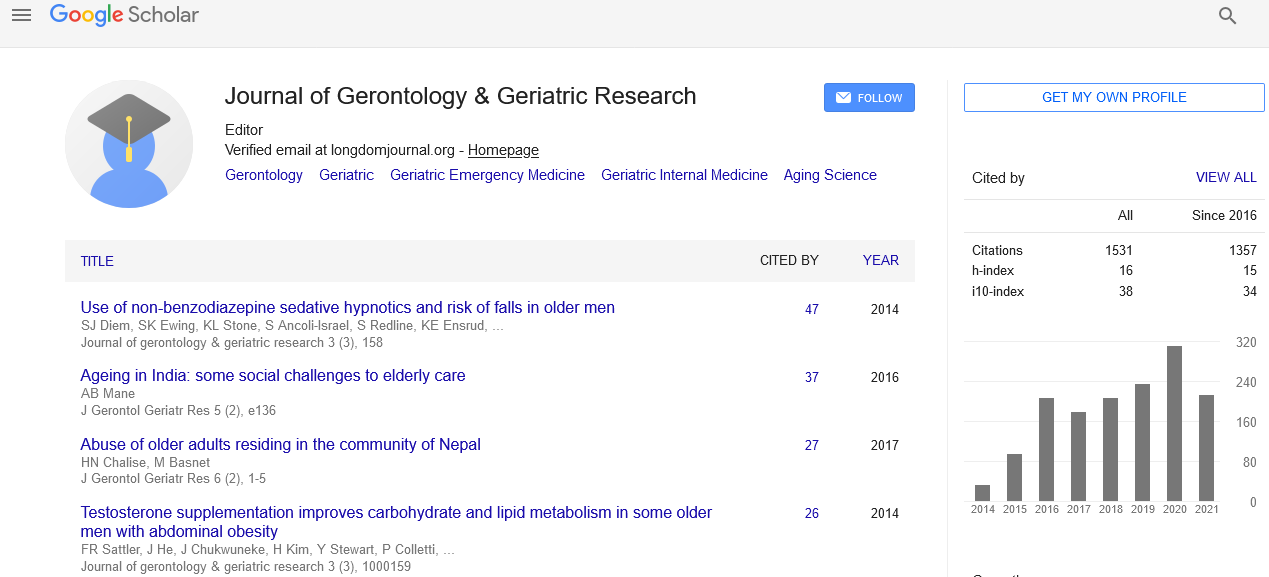PMC/PubMed Indexed Articles
Indexed In
- Open J Gate
- Genamics JournalSeek
- SafetyLit
- RefSeek
- Hamdard University
- EBSCO A-Z
- OCLC- WorldCat
- Publons
- Geneva Foundation for Medical Education and Research
- Euro Pub
- Google Scholar
Useful Links
Share This Page
Journal Flyer

Open Access Journals
- Agri and Aquaculture
- Biochemistry
- Bioinformatics & Systems Biology
- Business & Management
- Chemistry
- Clinical Sciences
- Engineering
- Food & Nutrition
- General Science
- Genetics & Molecular Biology
- Immunology & Microbiology
- Medical Sciences
- Neuroscience & Psychology
- Nursing & Health Care
- Pharmaceutical Sciences
Geriatric care in India
International Conference on Geriatrics & Gerontology
July 08-10, 2014 DoubleTree by Hilton Hotel Chicago-North Shore Conference Center, USA
Niranjan Venkatatamarao Gummraju and KP Rao
Accepted Abstracts: J Gerontol Geriat Res
Abstract:
Aging of population is an end product of demographic transition. The number of elderly people in developing countries is almost 3-4 times of that of developed countries. World population of 6.1 billion at the dawn of 21st century is likely to become 9.3 billion in 2050 (UN 2004). Global aged population from 595 million to 2 billion ? a fourfold rise-by 2050! In terms of proportion -10% in 2000, 15% by 2025, rising to 21.6% by 2050. 73% of deaths in the elderly are related to heart diseases, smoking and cancers. 20% of doctor?s visits, 30% of hospital days and 50% of bedridden days are ascribed to elderly patients. ?Expansion of morbidity? even though increased life expectancy due to chronic non-communicable diseases. 24 million in 1961 increased to 77 million in 2001. Projected to rise to 179 million in 2031 and 301 million in 2051. 70 and above projected to increase from 29 million in 2001 to 132 million in 2051. 80+ would be fastest to grow ? 8 million in 2001 to 32 million in 2051, 2nd largest elderly (60+) population in the world (2001). 80% are in rural areas, 40% are below poverty line, over 73% are illiterate, about 90% of the old people have no official social security (i.e., without PF, Gratuity and Pension etc). Life expectancy 31.7 years in 1941 increased to 60.5 years in 2000. 55% of the women of 60 years and above are widows. In India, geriatric services are largely unorganized. There are 186 old age homes, 233 day care centers and 28 medical vans. These are managed by NGO/network of PHC and subentries in the rural areas. At present most elderly patients are still being treated in general medical wards. In 1999, Indian Government announced a National Policy on Older Persons. In December 2007, Indian Parliament passed a bill known as Maintenance of Parents and Senior citizens Act to encourage geriatric units in hospitals and clinics, Infirmary care units. Emphasis was on family care of the aged through incentives and schemes for the needy families, promotion of values through formal education and media and subsidizing old age homes and day care centers. Elderly population in India is increasing and geriatrics is in incipient stage. NGOs have important role to play in creating awareness, imparting information and training of support services. We need to learn from the model of geriatric care in the developed countries.
Biography :
Niranjan Venkatatamarao Gummraju, B.Sc, MBBS, MD [Community Medicine], PG FAIMER Fellow, is presently working as Director, Curriculum Development Department and Research Development Department at Rajiv Gandhi University of Health Sciences, Karnataka, 4th ?T? Block, Jayanagar, Bangalore 560041. He has 29 years of experience in various fields like Teaching, Research, Administration etc. He actively participated in Teaching & Training Programmes for UG, PG, Para Medical Staff and National Health Programmes. He participated in around 21 International/National/State Level Symposiums, Seminars and Workshops. He discharged duties of Registrar & Registrar (Evaluation) of Rajiv Gandhi University of Health Sciences, on many occasions. He is a member of Staff Selection Committee of different affiliated colleges. He has several research publications in national and international journals.


